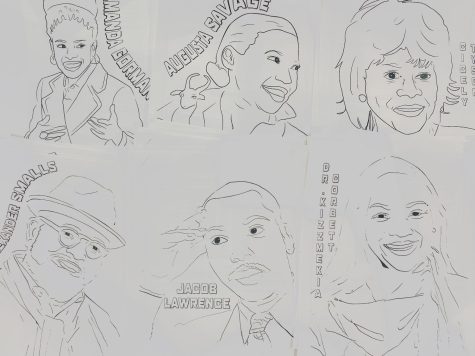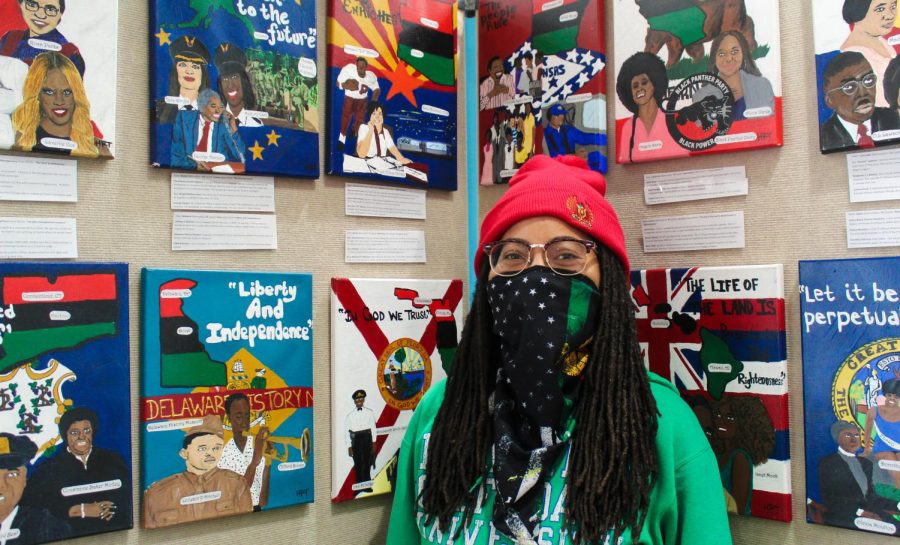Buncombe County libraries celebrate Black History Month
Heather Tolbert, Flowstate artist in residence, poses in front of her Black History Month display at the East Asheville Public Library.
February 15, 2022
Throughout Buncombe County’s 11 public libraries, Black History Month is in full swing. From curated reading lists and book groups to virtual events, the shortest month of the year is jam-packed with opportunities to learn, educate and explore Black history.
“Many of the libraries have book displays or reading lists, but we’re also doing something special at our branch. We’re hosting a series of artists in residence at the library’s Flowstate Community Arts Space this year and this month’s artist has done something special to celebrate Black Legacy Month. She’s created a series of coloring and activity sheets featuring famous African-Americans that people can pick up while they are in the library,” said Alexandra Duncan, East Asheville Library branch manager.
Heather Tolbert is this month’s featured artist. Over the last three years, she profusely researched Black history state by state and translated her discoveries into a series of canvases featuring prominent Black figures across the United States.
“I always wanted to make something to help me educate myself about Black history through fun ways, as much as I love reading and investigating. When the pandemic hit, it kind of struck me, like what would happen if I had an activity book I was interested in? So I decided to make something where you could learn both the states and state capitals as well as pieces of Black history in each state,” Tolbert said.
Each work of art begins with a different state as the background. Detailed portraits of both historic and modern Black figures fill up empty spaces. Surrounding them, representational motifs alluding to their accomplishments finalize the paintings.
“There were a bunch of people I didn’t know about when I started researching for this project but who I really became inspired by. Not just because of their story and talent, but because of their overcoming adversity, racism, sexism and all that. They constantly had to prove themselves to get to where they were and are,” Tolbert said.
Originally from Burnsville, Tolbert moved to Asheville after completing her M.S. in forensic studies and started her own substance abuse counseling program, From the Ashes Cultural Arts and Counseling, with her sister, Ashley.
“Me and my sister are substance abuse counselors. We offer counseling, education, facilitation and help people to feel more empowered. We help them get their licenses back, provide useful classes and act as supervisors all while bringing art into that healing, too,” she said.
For Tolbert, art is a way to heal and educate both herself and those around her.
“Growing up in schools, all this history isn’t in there except for the typical Martin Luther King, Jr. and Rosa Parks, which is fine because they’re the catalyst. But it’s important to know there’s a before and after them too,” Tolbert said.
Apart from the paintings in the East Asheville Library gallery, Tolbert created a set of coloring pages and activity sheets featuring important people in Black history. These free resources in the library lobby offer community members of all ages a chance to learn more through creativity and fun.
Anne Burns, an Asheville local and mother of two, picked up multiple copies of Tolbert’s activity sheets for her children.
“I think it’s a great way for kids, and even adults too, to use it for engaged learning. I’m hoping while my kids color in the pictures, we can turn it into a mini research project and learn more about the positive and important impact these people have had on our history,” she said.
Duncan said library staff encourage people to take an activity sheet home, color it in and bring it back to be hung up in the lobby.
“We’re hoping we’ll soon be able to cover this space with everyone’s art,” Duncan said.

As the chosen resident artist, Tolbert will be at the library throughout the month displaying her work and sharing it with community members.
“I want people to know the information is out there, and it’s not all so tragic like Trayvon Martin or Emmett Till. Maya Angelou stopped speaking, Malcolm X went to prison and they both came out of it and still made an important life for themselves in the time they had,” Tolbert said.
Tolbert said she wished her childhood and young adult life included greater representation of Black figures, their accomplishments and contributions to society.
“Hearing everything Black people have created and the things we continue to achieve today, it just makes me think a lot. My nieces, they’re getting to learn all this stuff in school nowadays, but if I had known this when I was younger, I wouldn’t feel so bad about being a Black person in the place I am,” she said.
To combat the lacking narratives around Black history and culture, Tolbert made sure her artwork, coloring pages and activity sheets were intersectional and well-representative of various backgrounds, lifestyles and contributions.
“I really focused on incorporating LGBTQ members and people who suffered from addiction, trans people, women and all these things history often shys away from, especially when talking about the Black community. It felt necessary to try and uncover a lot of what has been covered up in history,” Tolbert said.


![Brooke Pedersen [second from the right] and Luis Reyes [right] hold banners during the Wrap The Woods event.](https://thebluebanner.net/wp-content/uploads/2025/09/ELIZABETH_PRITCHITT_IMG_3470-1200x804.jpg)















